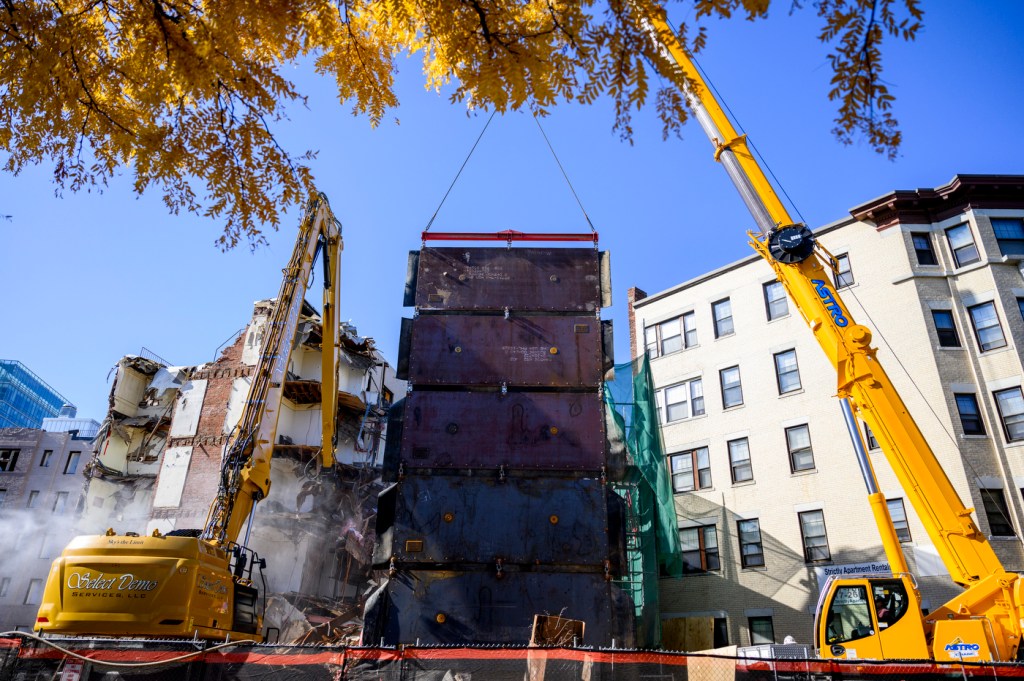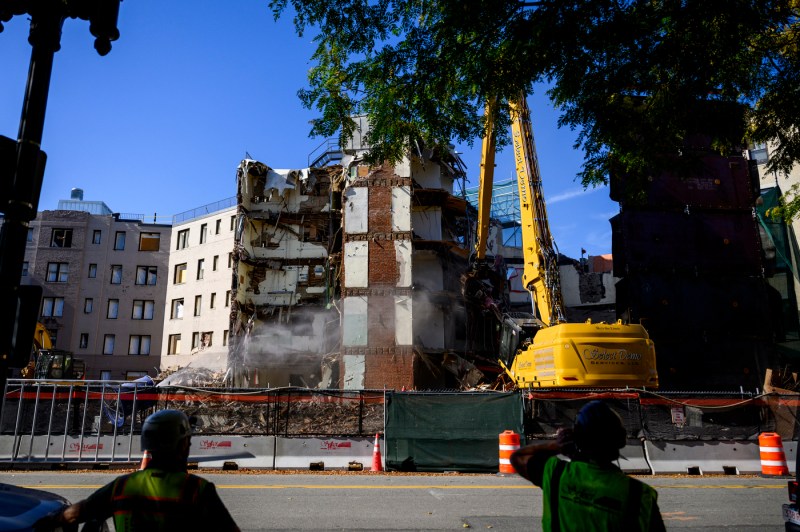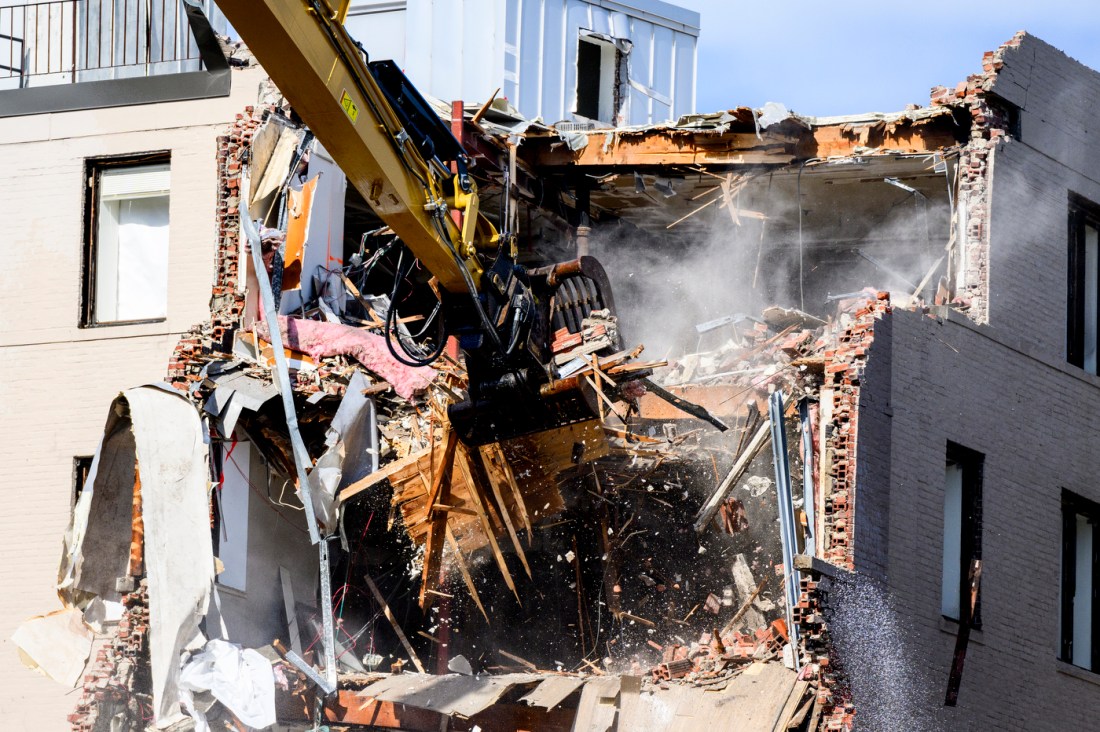How is Northeastern tackling the complex demolition of White Hall?
The crews are tearing down the building in a counterclockwise direction, and started the demolition process on the building’s northeastern side as it was the most structurally unsound.

Tearing down a five-story, 89,378-square-foot building along a busy street on a bustling college campus in the middle of a major city isn’t easy.
Fortunately, Northeastern University’s Planning, Real Estate and Facilities Department knows how to handle the demolition of White Hall, the former residence building on Forsyth Street.
The university began demolishing the dormitory last month.
Bringing down a building of that scale requires months of careful planning and communication with the city, neighboring building tenants and owners, and the crews brought in to survey and tear down the site, explains Juan Gil Figueroa, Northeastern University’s senior capital project manager.




“There’s a lot of people that travel through that area to get to and from places,” Figueroa says. “We want to cut down our impact and be good neighbors.”
Before demolition began, the facilities team conducted a ground-penetrating radar test, which uses lidar technology to create a 3D exterior map of the building. That helped the crews get a better understanding of the building’s structural weak points, Figueroa says.
They also were cognizant of collecting items and materials that could be reused, including furniture, 100 light bulbs — which were donated — and 279 door lock systems.
One way the facilities team is reducing disruptions during the demo is by minimizing construction noise as much as possible. Demolition crews don’t start working until 7 a.m. as part of a city ordinance.
Additionally, the crew has erected barriers around the property to keep pedestrians out of harm’s way and have a traffic plan in place for the demolition trucks to follow to reduce traffic disruptions along Forsyth Street and Huntington Avenue.
The project has been broken into two phases.
As part of phase one, the crews are tearing down the portion of the building not directly impacting Huntington Avenue to help minimize traffic disruptions. Crews will tear down portions that impact Huntington Avenue in phase two.
Onlookers of the demo site may notice the 30,000-pound steel plate wall being hung on a crane. It serves a very specific purpose, Figueroa explains.
The steel plate essentially acts as a barrier between the construction site and the road. Every day, the demo team anticipates where they imagine the parts of the building may fall as they tear it down to determine where the plate should be placed.
“The crane operator and the operator of the excavation know where they are working,” Figueroa says. “As the demolition gets done, they are moving the plate to align to where it may cause issues. They are fully coordinated at all times.”
And to protect against debris, the rubble is being soaked using a large sprinkler spraying out water, Figueroa added.
The crews are tearing down the building in a counterclockwise direction, and started the demolition process on the building’s northeastern side as it was the most structurally unsound.
The plan is to have the property fully torn down by the end of the year, Figuera explains.
Jeremy Munn, Northeastern professor of architecture and a former program director with the Planning, Real Estate and Facilities department, says that tearing down a building can often be more challenging than putting a building up, and it’s not something universities do on a normal basis.
From figuring out how to prevent debris from falling into public ways to turning off and removing underground infrastructure safely, knocking down a building can be a complicated process, he explains.
“There’s really very low risk tolerance for something to go wrong,” he says. “You really have to implement best practices — from a dust, noise, material-falling, and vibration perspective.”
Northeastern’s facilities team has no doubt thought about those factors, Munn says, highlighting one of the most interesting and “innovative” aspects of the White Hall tear down is the steel plate wall.
“I had never seen that before,” he says. “It’s pretty cool and probably very cost-efficient. Instead of building a giant scaffold that would take weeks to build, you’re hanging steel plates to act as that shield. That’s a pretty innovative way to provide safety for the general public.”
Another important consideration is sustainability, explains Nancy Varney, a civil and environmental engineering professor at Northeastern.
For example, it’s important to dispose of the torn down building materials in an environmentally sustainable manner, she says.
Figueroa says most of the materials being removed are being brought to waste treatment management plants, but metal-based scrap is being salvaged by the subcontractors hired by the university.
Varney says she’s encouraged by the university’s efforts on that front.
“Seeing that as part of the demolition process and has been well thought of makes you feel better about the whole thing,” Varney says.
